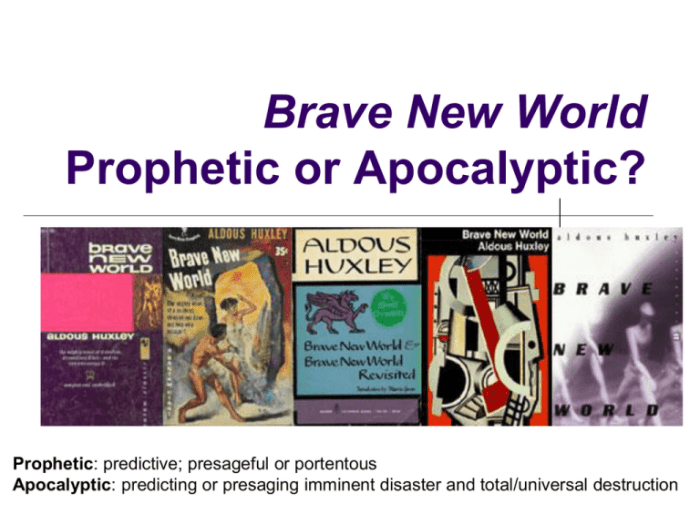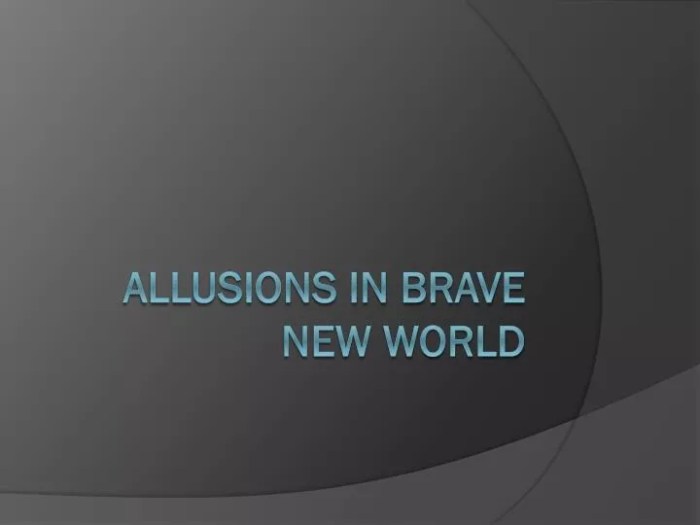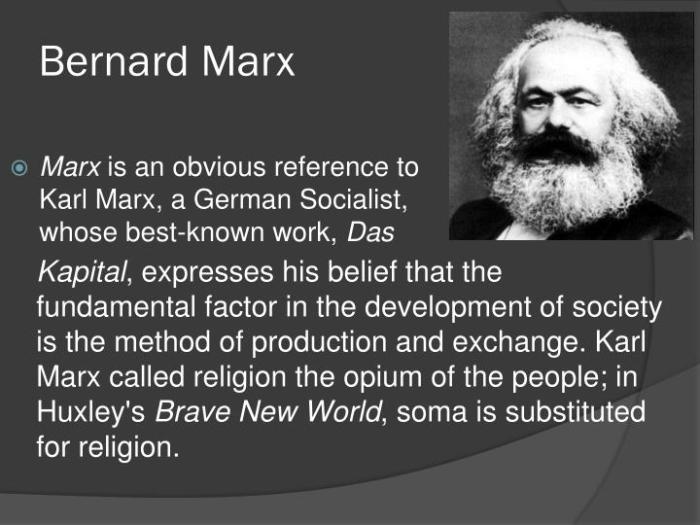Allusions in Brave New World, Aldous Huxley’s dystopian masterpiece, provide a rich tapestry of literary, historical, and cultural references that enhance the novel’s depth and meaning.
These allusions not only enrich the narrative but also offer profound insights into the novel’s themes and characters, inviting readers to engage in a deeper exploration of the human condition.
Literary Allusions

Allusions to classical literature play a significant role in Brave New World, enriching the novel’s themes and characterization.
These allusions draw parallels between the dystopian world of the novel and the societies depicted in classic works, highlighting the novel’s critique of totalitarianism and its dehumanizing effects.
Shakespearean Allusions
Allusions to Shakespeare’s works are particularly prevalent, with characters quoting or referencing plays such as “Hamlet,” “Macbeth,” and “Romeo and Juliet.” These references serve to:
- Establish a sense of irony and foreshadowing, as the characters’ fates often mirror those of their Shakespearean counterparts.
- Highlight the theme of forbidden love and societal repression, as in the case of John and Lenina’s relationship.
- Emphasize the novel’s critique of consumerism and the loss of individuality, as exemplified by the characters’ superficial and meaningless lives.
Historical Allusions

Brave New World incorporates various historical allusions to critique societal norms and explore human nature. These references serve as cautionary tales, highlighting the potential consequences of unchecked societal control and the erosion of individuality.
Allusions to the French Revolution
The novel draws parallels between the World State and the excesses of the French Revolution. The Reign of Terror, a period of widespread violence and executions, is echoed in the World State’s use of soma to suppress dissent and maintain stability.
The novel suggests that the pursuit of equality and fraternity, when taken to extremes, can lead to tyranny and the suppression of individual freedoms.
Allusions to World War I
Brave New World also alludes to the horrors of World War I. The Savage Reservation, where John the Savage is raised, represents a primitive and violent world that is a stark contrast to the controlled society of the World State.
The novel suggests that the horrors of war can lead to a longing for a simpler time, but also warns against the dangers of romanticizing the past.
Biblical Allusions
Brave New World is replete with biblical allusions, which serve to enhance the novel’s moral and ethical themes. These allusions draw parallels between the characters and events in the novel to those in the Bible, providing a deeper layer of meaning and symbolism.
Adam and Eve
The novel’s characters, John and Lenina, can be seen as modern-day Adam and Eve. Like their biblical counterparts, they are the first to experience the “forbidden fruit” of free will and individuality in a society that values conformity and stability.
Their actions, including their pursuit of forbidden knowledge and their subsequent expulsion from society, mirror the story of Adam and Eve in the Garden of Eden.
The Flood
The novel’s climactic scene, where John and Lenina confront the savage outside the reservation, can be interpreted as a modern-day version of the biblical flood. The savage represents the natural world, which has been repressed and denied in the civilized world.
His appearance signifies the coming of a new era, one in which the old order will be swept away and a new one will be established.
The Apocalypse
The novel’s final chapter, which depicts the destruction of the World State, can be seen as a modern-day apocalypse. The bombing and the subsequent chaos represent the end of the old world and the beginning of a new one. The novel’s ending leaves open the possibility of hope and redemption, as the characters search for a new way to live in a world that has been forever changed.
Allusions to Shakespeare
In Aldous Huxley’s dystopian novel Brave New World, allusions to Shakespeare’s plays serve as powerful literary devices that enhance the novel’s exploration of central themes and character development. These allusions resonate with readers familiar with Shakespeare’s works, inviting them to draw parallels between the characters and situations in Brave New Worldand those in Shakespeare’s plays.
Through these allusions, Huxley explores the universal themes of love, identity, and the nature of humanity. By juxtaposing Shakespeare’s timeless insights with the dystopian society he depicts, Huxley invites readers to reflect on the enduring relevance of these themes and the ways in which they are shaped by the social and technological context.
The novel Brave New World is replete with allusions to classical literature, history, and mythology. These allusions serve to enrich the novel’s themes and characters. For example, the character of John the Savage is an allusion to the biblical figure of John the Baptist.
The use of acme thread taps and dies in the novel is another example of an allusion. Acme thread taps and dies are precision tools used in metalworking. Their inclusion in the novel suggests that the society of Brave New World is highly industrialized and technologically advanced.
The Tempest
The most prominent Shakespearean allusion in Brave New Worldis to Shakespeare’s play The Tempest. The novel’s protagonist, John, is often compared to Prospero, the powerful magician in The Tempest. Like Prospero, John possesses a deep understanding of the world and a desire to shape it according to his own vision.
However, unlike Prospero, John’s power is limited by the society in which he lives. He is unable to escape the conditioning that has been imposed upon him, and he ultimately fails in his quest to create a better world.
Hamlet
Another significant Shakespearean allusion in Brave New Worldis to Hamlet. The novel’s main antagonist, Mustapha Mond, is often compared to Claudius, the king who murders Hamlet’s father. Like Claudius, Mond is a ruthless and manipulative leader who is willing to do whatever it takes to maintain his power.
However, unlike Claudius, Mond is not motivated by personal ambition. Instead, he is driven by a desire to create a stable and efficient society, even if it means sacrificing individual freedom and happiness.
Allusions to Mythology

Brave New World features numerous allusions to Greek and Roman mythology, enriching its symbolism and exploring the human condition.
Orpheus and Eurydice
The myth of Orpheus and Eurydice is a central allusion in the novel. John, the Savage, represents Orpheus, who seeks to bring back his beloved, Linda, from the underworld (the World State). However, like Eurydice, Linda is ultimately lost due to John’s violation of the rules (the forbidden fruit).
Icarus and Daedalus
The Icarus and Daedalus allusion parallels John’s rebellion against the World State. Like Icarus, John’s flight to the Savage Reservation is fueled by curiosity and a desire for freedom. However, he overreaches and is ultimately destroyed.
Prometheus
John is also associated with Prometheus, the mythological figure who stole fire from the gods and brought it to humanity. John’s actions in challenging the World State’s control over knowledge and emotions parallel Prometheus’s rebellion against the gods.
Pandora’s Box
The allusion to Pandora’s Box represents the World State’s suppression of natural instincts and emotions. The opening of the box, like the release of the forbidden fruit in the Garden of Eden, brings both knowledge and suffering.
Allusions to Popular Culture
Aldous Huxley’s Brave New Worldis a dystopian novel that critiques consumerism and mass media through its use of allusions to popular culture.
One of the most striking examples of this is the novel’s use of the phrase “feelies.” This term refers to a type of entertainment that is experienced through the senses, and it is a clear allusion to the early days of cinema.
In the novel, feelies are used to control the population and to keep them docile and unthinking.
Another example of an allusion to popular culture in Brave New Worldis the character of Mustapha Mond. Mond is the World Controller, and he is a clear parody of Henry Ford. Ford was the founder of the Ford Motor Company, and he was a pioneer in the field of mass production.
In the novel, Mond uses mass production techniques to create a society that is efficient and controlled.
These are just a few examples of the many allusions to popular culture that can be found in Brave New World. These allusions help to create a sense of realism and to make the novel’s critique of consumerism and mass media more powerful.
The Role of Feelies in the Novel
Feelies play a significant role in Brave New World. They are used to control the population and to keep them docile and unthinking. The feelies are a form of entertainment that is experienced through the senses, and they are designed to be as immersive as possible.
The feelies are a powerful tool for control because they can be used to create any kind of experience that the government wants. They can be used to create feelings of happiness, sadness, anger, or fear. They can also be used to create illusions and to make people believe things that are not true.
The feelies are a major part of the World State’s propaganda machine. They are used to promote the government’s ideology and to make people believe that they are living in the best of all possible worlds.
Effects of Allusions
Allusions in Brave New Worldenrich the novel’s meaning and impact on the reader. By referencing other works, Huxley establishes a dialogue between his novel and literary, historical, and cultural traditions. This dialogue deepens the novel’s complexity and universality.
Enhancing Reader Understanding
Allusions provide a bridge between the familiar and the unfamiliar, helping readers connect with the novel’s themes and characters. By referencing familiar works, Huxley creates a sense of recognition and resonance, allowing readers to draw parallels between the novel and their own experiences and knowledge.
Contributing to Richness and Complexity
Allusions add layers of meaning to the novel. They evoke historical, literary, and cultural contexts, enriching the novel’s tapestry and inviting readers to engage with multiple levels of interpretation. By juxtaposing different perspectives and ideas, allusions create a complex and multifaceted narrative.
Establishing Universality
Allusions to timeless works, such as Shakespeare’s plays or Greek mythology, connect Brave New Worldto a broader human experience. These references suggest that the novel’s themes and concerns are not limited to its specific time and place but resonate with universal human conditions.
Table of Allusions
The following table categorizes and summarizes the allusions found in Brave New World. Each entry includes the type of allusion, the specific reference, and its significance in the novel.
Allusions in Brave New Worldserve several purposes. They establish the novel’s intellectual and cultural context, provide insight into the characters’ thoughts and feelings, and create a sense of irony and foreshadowing.
Type of Allusion
- Literary: References to other works of literature, such as Shakespeare’s plays or the Bible.
- Historical: References to real-world events or figures, such as the First World War or Henry Ford.
- Biblical: References to the Bible or Christian tradition, such as the Garden of Eden or the Book of Revelation.
- Shakespearean: References to the works of William Shakespeare, such as Hamletor Macbeth.
- Mythological: References to Greek or Roman mythology, such as the myth of Icarus or the story of Prometheus.
- Popular Culture: References to contemporary popular culture, such as movies, songs, or advertising slogans.
Specific Reference
- “Brave New World”: A reference to Shakespeare’s The Tempest, in which the character Miranda describes a utopian society.
- “The World State”: A reference to the totalitarian government in Aldous Huxley’s novel.
- “The Bokanovsky Process”: A reference to the process of artificial reproduction that creates identical twins.
- “Soma”: A reference to the drug that is used to control the population in Brave New World.
- “The Savage”: A reference to the character who represents the natural world and traditional values.
Significance
- Literary: Allusions to other works of literature establish the novel’s intellectual and cultural context.
- Historical: Allusions to real-world events or figures provide insight into the novel’s social and political themes.
- Biblical: Allusions to the Bible or Christian tradition explore the novel’s religious and philosophical themes.
- Shakespearean: Allusions to the works of William Shakespeare provide insight into the characters’ thoughts and feelings.
- Mythological: Allusions to Greek or Roman mythology create a sense of irony and foreshadowing.
- Popular Culture: Allusions to contemporary popular culture reflect the novel’s satirical and dystopian themes.
Timeline of Allusions

The following timeline presents the allusions in Brave New Worldin chronological order, providing brief descriptions of each allusion and its context within the novel:
Literary Allusions
* “O brave new world”(Act V, Scene I of The Tempestby William Shakespeare): This allusion is spoken by John the Savage after he first encounters the futuristic society of the World State. It reflects his initial awe and wonder at the technological advancements and social order he witnesses.
“The world is too much with us”(from the poem “The World Is Too Much with Us” by William Wordsworth)
This allusion is used to describe the overwhelming materialism and consumerism of the World State, which stifles individuality and true human connection.
“We can’t go back”(from the novel Tender Is the Nightby F. Scott Fitzgerald)
This allusion is spoken by Mustapha Mond to John the Savage, emphasizing the impossibility of returning to a pre-industrial, natural world once society has progressed to a certain point.
“I have measured out my life with coffee spoons”(from the poem “The Love Song of J. Alfred Prufrock” by T.S. Eliot)
This allusion is used to describe the mundane and repetitive nature of life in the World State, where individuals are conditioned to conform and find meaning in superficial pleasures.
Quotations with Allusions: Allusions In Brave New World
Aldous Huxley’s Brave New Worldis replete with allusions to literature, history, and mythology. These allusions serve to enrich the novel’s themes and characters, providing a deeper understanding of the world Huxley creates.
The following are some notable quotations from Brave New Worldthat contain allusions:
Allusion to Shakespeare’s The Tempest
“O brave new world, that has such people in’t!”
This famous line, spoken by Miranda in Shakespeare’s The Tempest, is uttered by John the Savage when he first encounters the World State. The allusion suggests that the World State is a brave new world, full of possibilities and potential. However, it also foreshadows the dystopian nature of the World State, as Miranda’s line is spoken in ignorance of the dangers that await her on the island.
Allusion to the Bible
“And God created man in his own image.”
This line, from the Book of Genesis, is alluded to in the novel when the Director of Hatcheries and Conditioning explains the process of creating human beings in the World State. The allusion suggests that the World State is attempting to play God by creating human beings in its own image.
However, this process is ultimately flawed, as the human beings created in the World State are not truly free or individual.
Allusion to Greek Mythology, Allusions in brave new world
“Icarus, my son!”
This line, spoken by Daedalus in Greek mythology, is alluded to in the novel when John the Savage tries to escape from the World State. The allusion suggests that John’s attempt to escape is doomed to failure, as Icarus’s attempt to fly too close to the sun resulted in his death.
These are just a few of the many allusions found in Brave New World. These allusions add depth and richness to the novel, providing a deeper understanding of the world Huxley creates.
Query Resolution
What is the significance of allusions to Shakespeare in Brave New World?
Allusions to Shakespeare’s plays contribute to the novel’s exploration of themes such as love, identity, and the nature of humanity, providing a rich literary context for Huxley’s dystopian vision.
How do biblical allusions shape the novel’s moral and ethical themes?
Biblical allusions in Brave New World highlight the novel’s critique of societal values and its exploration of the moral and ethical dilemmas faced by its characters.